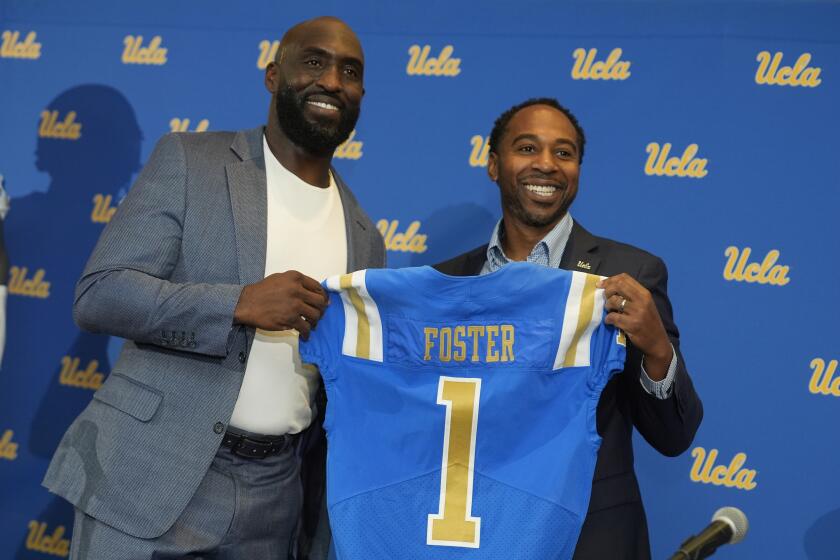Baseball’s Chronic Losers Find It’s Very Difficult to Change
- Share via
PHOENIX — The ride from baseball’s poorhouse to its penthouse usually requires the necessary mortgage money to pay for the trip.
Ask the fans in Cleveland. Or Texas. Or San Francisco. Or even the Chicago Cubs.
While repeating as a division champion is as rare as a hot dog without mustard, there have been some trends of mediocrity in the major leagues over the past decade.
Discounting the two expansion franchises in the American League--Seattle and Toronto--the words long suffering have been nearly the exclusive domain of the Indians, Rangers, Giants and until 1984, the Cubs. All four clubs have had three or fewer above .500 campaigns during the decade--the usual mark for a club’s success.
Give the Mariners two more years and they will qualify for the 10-year mediocre club. The Mariners haven’t been above .500 yet but they have expansion as an alibi. The Blue Jays are defending American League titlists and have posted three straight above .500 years.
The usual theories given for mediocrity include: Unwillingness to spend money; poor trades; inadequate farm system, or a combination of all three.
In the past decade, the Indians have finished over .500 three times. Twice, they were one game over and their “banner” campaign was the 81-78 finish in 1976. Cleveland was 60-102 last year.
The Rangers have also posted just three above .500 campaigns and they were all in a row, 1977-79 when the club competed for the AL West crown. In three of the last four, Texas has lost 98, 92 and last year’s 99 defeats.
Neither club has won a flag in that period with the Indians’ drought since 1954 the longest in the junior circuit.
Why the continuing mediocrity?
Lou Boudreau, the former Indians shortstop-manager Hall of Famer, points toward financial and trade blunders.
“They haven’t had the patience with some of their players like we had back in the 1940s,” Boudreau says. “It can be turned around there but you have to keep your players by paying them instead of trading them.”
Point toward a rotation of Bert Blyeven, Rick Sutcliffe, John Denny and Dennis Eckersley and you would have one of the best if not the best starting staff in baseball. Instead, the four are toiling elsewhere.
Cleveland has had to compete in a strong division, something the Rangers haven’t had to contend with in the decade.
The Rangers flourished under Billy Martin and then he left and so did the team’s competitiveness. The young players of promise that were supposed to turn the team around--beginning with Bump Wills and continuing for nearly a decade through Billy Sample--have seldom blossomed.
The Giants, once the dominant team in the National League, have just three plus .500 finishes in the decade--1978, 1981 and 1982. Last year, the club lost 100 games, four more than in 1984.
“I couldn’t wait to get out of there. It was like a new lease on life,” said Jack Clark, who rode the elevator up from the bottom with the Giants to the top with the NL champion St. Louis Cardinals last year.
The Giants have had a history, like Cleveland, of making poor deals. Letting Clark go for four players--none of whom had good seasons--was typical of the frustrating deals San Francisco had made.
How would a lineup of Clark, George Foster, Darrel Evans, Larry Herndon, Dave Kingman and Dusty Baker sound for starters? Quite a wallop. They all claim one thing in common besides power; they are all ex-Giants.
The Cubs are lumped into the quartet of mediocrity for two reasons; before the 1984 NL East Division flag, Chicago hadn’t been above .500 since 1972. Over the decade, the Cubs still have that one over .500 campaign in 1984. Three times the Cubs lost 89 or more games and in the strike-torn 1981 campaign, Chicago lost 37 of its first 52 before the walkout mercifully cut into the team’s campaign.
But the Cubs, victims of poor trades, unwillingness to spend money and an inadequate farm system, showed it could be turned around.
“When I got here, all people were content with was showing up, maybe playing .500 and sitting in the afternoon sun,” said Cubs’ President-General Manager Dallas Green. “We knew it would take a couple of years but we proved it could be done.”
Flushed with fresh financing from the new owners, the Chicago Tribune Co., Green got just enough free agents to start the team on the road to winning. He also made great trades--acquiring Sutcliffe from Cleveland, Ryne Sandberg and Keith Moreland from Philadelphia, Eckersley from Boston and Steve Trout from the White Sox.
He also spent money developing the farm system and was able to give up promising players like Joe Carter and Mel Hall to the Indians to land Sutcliffe.
“I know the Cubs had a history of losing when I got here,” Green said. “I wasn’t about to stand for it. I came from a winning tradition in Philadelphia. We have it here, now.”
But even the right ingredients don’t always spell sucess. Riddled with injuries, the Cubs slumped to 77-84 last year.
Ten years from now, another survey could be made and the teams could change. Pittsburgh has fallen on rough times after domination in the 1970s and the Atlanta Braves have fallen from the top after winning a division four years ago.
More to Read
Go beyond the scoreboard
Get the latest on L.A.'s teams in the daily Sports Report newsletter.
You may occasionally receive promotional content from the Los Angeles Times.










